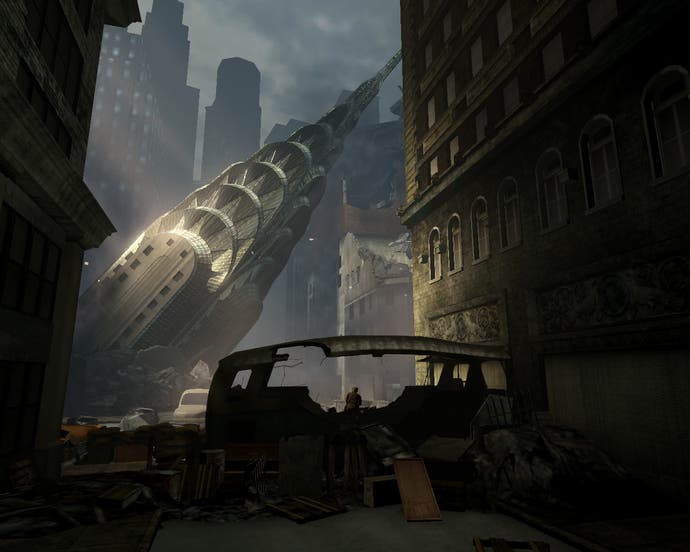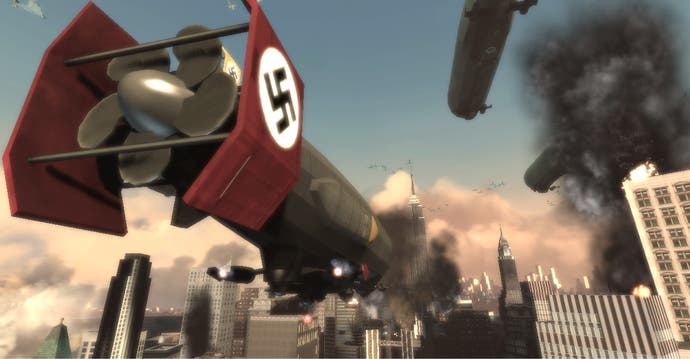Turning Point: Fall of Liberty
The Nazis invade America.
Surely it's time to put an end to World War II? I mean, how many Nazis/Japs can one gamer blow away before it gets boring? There's only so many battles you can fight, surely? Only so many theatres of war that you can shoot people in? Right? Wrong. Sort of. Now there's another theatre of war: the US of A. Turning Point: Fall of Liberty is the latest game by World War II FPS specialists Spark Unlimited, but it's got a twist: the Allies have lost their battle against the Nazis, and now Hitler's minions have invaded America.
And so to the labyrinthine bowels of the War Rooms, which is apparently where Churchill ran World War II. It's a good location to show off Turning Point because the game's counterfactual universe exists because Churchill wasn't around to run World War II. He was killed in a taxi cab accident in New York on December 13, 1931 - a twist of fate that ultimately results in the surprise Nazi invasion of New York some 20 years later. Which is where the game starts, accompanied by all the usual screen-shaking explosions and bombastic action that you've come to expect from the sort of authentically gritty World War II shooters that Spark has pioneered - except this one also throws in an alternate timeline, advanced technology, and a new emphasis on guerrilla tactics.
This is the team behind games in the Medal of Honor and Call of Duty series, and the company's CEO, Craig Allen reckons that each of those games marks an evolution in the way videogames depict war. From the unbridled heroism of Medal of Honor, to the war-is-hell survivalism in Call of Duty, and now, with Turning Point, to the personal impact of war - the way small twists of fate can affect everyday lives.

To judge from the various demos that Codemasters run through at the War Rooms, there's another way these games have evolved: they've got louder and more intense with each new instalment. The first demo of the afternoon starts off at the top of a skyscraper that's in the middle of being built. Then all hell breaks loose as Nazi planes fly overhead, gunning down builders, and bombing buildings, apparently meeting no opposition from US forces. There's an orchestral score, falling debris, massive explosions, and all the scripted chaos that World War II first person shooters have made their own.
But, as Allen points out, this isn't a conventional World War II game. For a start, the game's protagonist isn't the well-drilled military man of the previous two games. He's an average Joe construction worker (who just happens to have a capacity for inspired military heroics). The scenario sees this average Joe, or Dan Carson to give him his proper name, caught up in a history that's very different to our own. After Churchill is killed in that cab accident (a cab accident which actually really happened in real life, fact fans), history diverges from our own timeline, to see England surrendering in 1940, before American forces can be drawn into battle.
Thus, it comes as a complete surprise when the Wehrmacht attacks the East Coast in 1953, because, as Codemasters' David Brickley points out, the Nazis have, at their disposal, "The advanced weaponry that stems from another decade of uninterrupted, unchallenged research. And we know what they were coming up with towards the end of the Second World War as it was, with the V2 bombs and so on. That's where the blimps come from, the troop carriers that are capable of crossing the Atlantic. Why didn't they see it coming? Well it's 1953, there's no satellite."

And so to that enormously impressive opening set-piece, which ranges from vertiginous heights to claustrophobic tunnels, with the intensity never letting up. Take, for example, the moment in which Carson sneaks up behind a Nazi parachutist to break his neck, steal his weapon, and push him off the top of a tall building. Or the first moment where he grapples an enemy in order to shoot him in the chest at super close range. Or the first moment he takes his first human shield - apparently an essential tactic in some of the game's more open areas. Or the first moment a grenade goes off and your vision is reduced to a blur.

